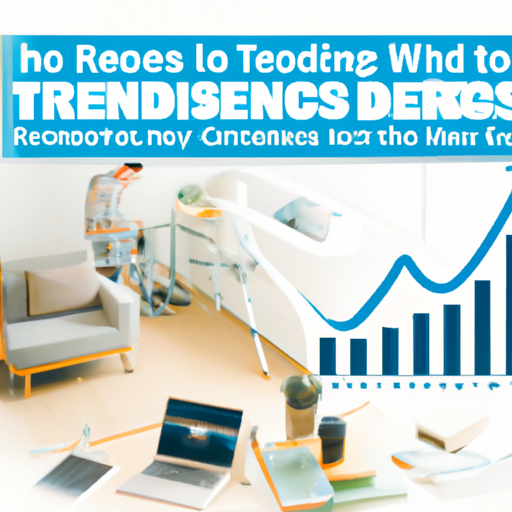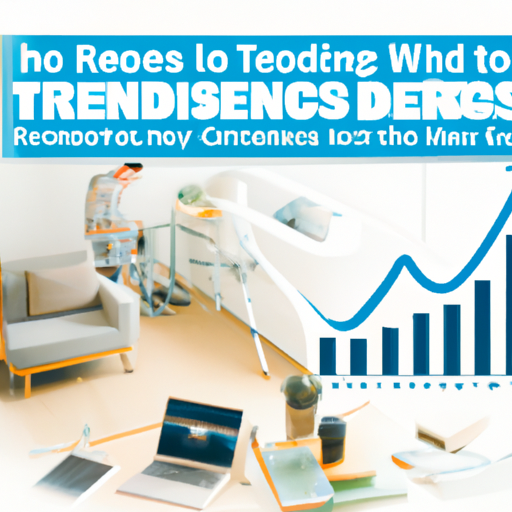Hvac Industry Trends
If you’ve ever wondered about the latest developments in the HVAC industry, this article is here to provide you with all the essential information. From advancements in energy-efficient technologies to the rising demand for smart home systems, the HVAC industry is evolving rapidly to meet the changing needs of consumers. Stay tuned to explore the latest trends and innovations shaping the future of heating, ventilation, and air conditioning.

Table of Contents
Sustainability in HVAC
Growing demand for energy-efficient systems
The HVAC industry is experiencing a growing demand for energy-efficient systems as businesses and homeowners alike recognize the importance of reducing their carbon footprint and conserving energy. Energy-efficient HVAC systems not only help to reduce greenhouse gas emissions, but they also offer significant cost savings in the form of reduced energy bills. With the advancement of technology, energy-efficient systems have become more accessible and affordable, making them a popular choice for consumers.
Emergence of eco-friendly refrigerants
Another key trend in the HVAC industry is the emergence of eco-friendly refrigerants. Traditionally, HVAC systems have used refrigerants that have high global warming potential (GWP) and contribute to ozone depletion. However, with growing concerns about environmental impact, there has been a shift towards the use of eco-friendly refrigerants, such as hydrofluoroolefins (HFOs) and hydrofluorocarbons (HFCs). These refrigerants have lower GWP and are more sustainable, making them a preferred choice for HVAC system manufacturers.
Integration of renewable energy sources
In line with the global push towards renewable energy, the HVAC industry is increasingly integrating renewable energy sources into HVAC systems. This integration allows for more sustainable and energy-efficient operation of HVAC systems. Renewable energy sources such as solar power and geothermal energy can be used to power HVAC systems, reducing reliance on non-renewable energy sources and minimizing environmental impact. This trend not only contributes to sustainability but also provides long-term cost savings for consumers.
Advancements in building automation systems
Advancements in building automation systems have also had a significant impact on the HVAC industry. Building automation systems utilize advanced technology, such as sensors and control algorithms, to optimize energy usage and enhance overall system performance. These systems can monitor and adjust HVAC settings based on occupancy patterns, weather conditions, and indoor air quality, ensuring optimal comfort while minimizing energy waste. The integration of building automation systems with HVAC systems has resulted in improved energy efficiency and sustainability.
Technological Advancements
Internet of Things (IoT) in HVAC systems
The Internet of Things (IoT) has revolutionized the HVAC industry by enabling seamless connectivity and communication between different devices and systems. IoT technology allows HVAC systems to be remotely monitored, controlled, and optimized for energy efficiency. Sensors and smart devices can collect real-time data on temperature, humidity, and occupancy, allowing for intelligent and automated HVAC control. The integration of IoT in HVAC systems has significantly improved energy efficiency, comfort, and overall system performance.
Smart thermostats and connected devices
A key technological advancement in the HVAC industry is the development of smart thermostats and connected devices. Smart thermostats offer advanced features such as learning algorithms, occupancy detection, and remote control capabilities. These devices can analyze user behavior and adjust temperature settings accordingly, optimizing energy usage and comfort. Furthermore, connected devices, such as smart vents and sensors, can work in tandem with smart thermostats to create a fully integrated HVAC system that maximizes energy efficiency and occupant comfort.
Remote monitoring and predictive maintenance
Remote monitoring and predictive maintenance have become increasingly important in the HVAC industry. Remote monitoring allows HVAC systems to be monitored in real-time, enabling quick identification of issues and proactive maintenance. By analyzing performance data, HVAC professionals can detect potential problems before they escalate, minimizing downtime and reducing repair costs. Remote monitoring also enables remote troubleshooting, eliminating the need for unnecessary site visits and improving efficiency.
Artificial intelligence and machine learning in HVAC
Artificial intelligence (AI) and machine learning technologies are making a significant impact on the HVAC industry. These technologies enable HVAC systems to analyze complex data patterns and make intelligent decisions on system operation and optimization. AI algorithms can learn from historical data and dynamically adjust parameters, such as airflow and temperature, to improve energy efficiency and occupant comfort. Machine learning also plays a crucial role in predictive maintenance, accurately predicting equipment failures and facilitating timely repairs.
Indoor Air Quality (IAQ)
Focus on improving air filtration systems
Indoor air quality (IAQ) has become a major concern in recent years, and the HVAC industry is placing a greater emphasis on improving air filtration systems. High-efficiency air filters can effectively capture and remove airborne contaminants, such as dust, pollen, and allergens, improving the overall air quality in indoor spaces. HEPA (high-efficiency particulate air) filters are particularly effective in removing small particles, making them popular in healthcare facilities and buildings with strict IAQ requirements.
Growing demand for UV germicidal irradiation
With the increased focus on hygiene and health, there has been a growing demand for UV germicidal irradiation in HVAC systems. UV germicidal lamps emit ultraviolet radiation that can kill or inactivate bacteria, viruses, and other pathogens. By installing UV lamps within HVAC systems, airborne pathogens can be sterilized, improving the overall indoor air quality and reducing the risk of airborne transmission of diseases.
Ventilation and air exchange considerations
Proper ventilation and air exchange are crucial in maintaining good IAQ. The HVAC industry is focusing on designing systems that provide adequate fresh air and ensure proper air exchange rates. This includes the use of energy recovery ventilation systems that capture and transfer heat or coolness from stale outgoing air to fresh incoming air. By maximizing the use of outdoor air and minimizing recirculation of indoor air, HVAC systems can improve IAQ and create a healthier indoor environment.
Air cleaning and purification technologies
Beyond air filtration and UV germicidal irradiation, the HVAC industry is also exploring other air cleaning and purification technologies. These technologies utilize various methods such as electrostatic precipitation, ionization, and activated carbon filtration to remove pollutants, odors, and volatile organic compounds (VOCs) from indoor air. Air purification systems can significantly improve IAQ, making them particularly valuable in environments where air quality is a critical consideration, such as hospitals, laboratories, and cleanrooms.

Heat Pump Technology
Increasing adoption of heat pump systems
Heat pump systems are gaining popularity in the HVAC industry due to their energy efficiency and versatility. Heat pumps are capable of both heating and cooling spaces by transferring heat between the indoors and outdoors. Unlike traditional heating and cooling systems that rely on the combustion of fossil fuels, heat pumps use electricity to move heat, resulting in significant energy savings. The increasing adoption of heat pump systems is driven by the desire for environmentally-friendly and cost-effective HVAC solutions.
Advancements in geothermal heat pumps
Geothermal heat pumps (GHPs) are a subset of heat pump systems that utilize the stable underground temperature for heating and cooling. GHPs rely on the relatively constant heat stored in the earth to provide efficient and sustainable HVAC solutions. Advancements in GHP technology, such as improved ground loop designs and more efficient heat exchangers, have made these systems even more attractive for both residential and commercial applications. GHPs offer long-term cost savings, reduced carbon footprint, and reliable year-round comfort.
Hybrid heat pump solutions
Hybrid heat pump solutions combine the benefits of heat pumps with traditional heating and cooling systems. These systems automatically switch between heat pumps and fossil fuel-based systems, such as gas furnaces or boilers, based on outdoor temperatures and energy prices. By utilizing the most efficient heating or cooling source at any given time, hybrid heat pump solutions optimize energy usage and provide reliable comfort. This flexibility makes them particularly suitable for regions with extreme temperature variations.
Heat pump water heaters
Heat pump technology is not limited to space heating and cooling but extends to water heating as well. Heat pump water heaters efficiently extract heat from the surrounding air and transfer it to the water, providing hot water for various applications. Compared to traditional electric water heaters, heat pump water heaters can save up to 60% in energy costs. They offer an environmentally-friendly alternative for residential and commercial water heating, contributing to overall energy efficiency and sustainability.
Energy Efficiency Regulations
Stringent energy efficiency standards
Energy efficiency regulations and standards are driving the HVAC industry towards more sustainable practices. Governments and organizations worldwide are implementing stringent energy efficiency standards for HVAC equipment to reduce energy consumption and greenhouse gas emissions. These standards specify minimum energy performance requirements, promoting the use of energy-efficient technologies and encouraging manufacturers to innovate and develop more sustainable HVAC solutions.
Phasing out of high GWP refrigerants
To address the environmental impact of refrigerants with high global warming potential (GWP), regulations are being implemented to phase out their use in HVAC systems. These regulations aim to transition to lower GWP refrigerants that have a reduced impact on global warming and ozone depletion. The phasing out of high GWP refrigerants, such as hydrochlorofluorocarbons (HCFCs) and hydrofluorocarbons (HFCs), is an essential step towards achieving sustainability and reducing the carbon footprint of HVAC systems.
Incentives and rebates for energy-efficient upgrades
To encourage the adoption of energy-efficient HVAC systems, governments and utility companies often offer incentives and rebates for energy-efficient upgrades. These incentives can offset the upfront costs of purchasing and installing energy-efficient equipment, making sustainable HVAC solutions more affordable and accessible. By providing financial incentives, governments and utility companies are driving the market towards more sustainable practices and encouraging the transition to energy-efficient technologies.
Energy performance labeling
Energy performance labeling is becoming increasingly common in the HVAC industry, allowing consumers to make informed decisions about the energy efficiency of HVAC equipment. Energy labels provide information about the energy consumption and efficiency rating of HVAC products, enabling consumers to compare different models and choose the most energy-efficient option. These labels also provide transparency and accountability for manufacturers, encouraging them to develop more energy-efficient products and contribute to overall sustainability.
HVAC System Integration
Integration of HVAC with building management systems (BMS)
The integration of HVAC systems with building management systems (BMS) has become a prevalent trend in the industry. BMS platforms allow for centralized control and monitoring of all building systems, including HVAC, lighting, security, and more. By integrating HVAC systems with BMS, building operators can optimize energy usage, track system performance, and automate routine tasks. This integration enables a more holistic and efficient approach to building operation, resulting in improved energy efficiency, occupant comfort, and maintenance practices.
Smart lighting and HVAC integration
Integration between smart lighting and HVAC systems is gaining popularity as buildings strive for enhanced energy efficiency and occupant comfort. By synchronizing the operation of lighting and HVAC systems, building operators can optimize energy usage based on occupancy patterns and natural lighting conditions. For example, the HVAC system can adjust temperature and airflow based on the lighting system’s occupancy detection, minimizing energy waste in unoccupied areas. This integration also enhances occupant comfort and overall building performance.
Collaborative solutions for optimized energy usage
The HVAC industry is embracing collaborative solutions that optimize energy usage across multiple systems and building components. Collaborative control platforms can analyze data from various sources, such as occupancy sensors, weather forecasts, and energy pricing, to make intelligent decisions about HVAC system operation. These platforms can dynamically adjust temperature and airflow, schedule equipment operation based on occupancy patterns, and prioritize energy-consuming systems. By considering the interaction between different systems, collaborative solutions maximize energy efficiency and achieve overall sustainability.
Integration with advanced analytics and control platforms
Advanced analytics and control platforms enable the HVAC industry to leverage big data and predictive modeling to optimize system performance. By analyzing vast amounts of data from sensors, weather forecasts, and historical patterns, these platforms can provide insights and recommendations for HVAC system operation and energy management. They enable predictive maintenance, energy optimization, and ongoing performance monitoring. The integration of HVAC systems with advanced analytics and control platforms enhances energy efficiency, reduces maintenance costs, and ensures optimal occupant comfort.
Demand for Zoning and Individual Control
Rise in demand for zoning systems
Zoning systems are becoming increasingly popular in the HVAC industry as they offer enhanced comfort and energy efficiency. Zoning allows for the division of a building into separate zones that can be independently controlled, enabling personalized temperature settings for different areas. By strategically controlling airflow and temperature in each zone, energy waste can be minimized, and occupant comfort can be optimized. Zoning systems are particularly beneficial in larger buildings, where different sections have varying occupancy and climate control requirements.
Individual control options for occupant comfort
Alongside the rise in demand for zoning systems, there is a growing expectation for individual control options in HVAC systems. Occupants want the ability to adjust temperature and airflow settings according to their personal preferences, promoting comfort and well-being. Individual control options, such as programmable thermostats and smartphone apps, enable occupants to have direct control over their comfort settings. This level of personalization not only enhances occupant satisfaction but also allows for energy savings by avoiding unnecessary heating or cooling of unoccupied spaces.
Zone-based ductless mini-split systems
Zone-based ductless mini-split systems are gaining traction in the HVAC market as an efficient and flexible solution for zoned heating and cooling. These systems consist of multiple indoor units that independently control the temperature of different zones. As the name suggests, ductless mini-split systems do not require ductwork for air distribution, making them ideal for retrofit applications or situations where ductwork is not feasible. With their individual control capabilities and energy-efficient operation, zone-based ductless mini-split systems offer personalized comfort and reduce energy waste.
Wireless control solutions for HVAC
Wireless control solutions are becoming increasingly popular as they offer convenience and flexibility in HVAC system control. Wireless thermostats and sensors can be easily installed and moved without the need for extensive wiring. They provide seamless communication with HVAC systems, enabling remote control and monitoring capabilities. Wireless control solutions also facilitate integration with other smart devices and platforms, allowing for comprehensive building automation. With their easy installation and user-friendly interface, wireless control solutions are fulfilling the growing demand for convenient and adaptable HVAC system control.
Skills Gap and Workforce Development
Shortage of skilled HVAC technicians
The HVAC industry is currently facing a shortage of skilled technicians, creating a significant skills gap. The demand for HVAC services continues to grow, but there are not enough qualified professionals to meet this demand. The shortage is due to various factors, including an aging workforce, lack of specialized training programs, and limited awareness of the HVAC industry as a viable career option. Addressing this skills gap is crucial to ensure the ongoing development and sustainability of the HVAC industry.
Need for training and upskilling programs
To bridge the skills gap in the HVAC industry, there is a need for comprehensive training and upskilling programs. These programs should focus on providing individuals with the necessary knowledge and skills to succeed in the industry. Training programs can cover a range of topics, including HVAC system installation, maintenance, troubleshooting, and energy efficiency practices. By investing in training and upskilling programs, the industry can attract and retain qualified professionals, ensuring the availability of skilled technicians to meet the increasing demand.
Promoting diversity and inclusivity in the HVAC industry
The HVAC industry has historically lacked diversity and inclusivity, with underrepresentation of certain demographic groups, including women and minorities. To create a sustainable and thriving industry, it is essential to promote diversity and inclusivity in the HVAC workforce. This can be achieved through outreach programs that encourage individuals from diverse backgrounds to pursue careers in the industry. Creating a more inclusive and equitable HVAC workforce will not only address the skills gap but also bring a broader range of perspectives and ideas to the industry.
Automation and technology-driven skill requirements
The advancement of technology in the HVAC industry has led to a shift in skill requirements. As automation and smart technologies become increasingly prevalent, HVAC technicians need to have a strong understanding of these technologies and how to troubleshoot and maintain them. Skills related to computer programming, data analysis, and system integration are becoming more important for HVAC professionals. As the industry becomes more technology-driven, continuous learning and adaptation to new technological advancements will be crucial for HVAC technicians to remain competitive and relevant.
HVAC Retrofitting and Upgrades
Increasing demand for retrofitting existing systems
As sustainability becomes a top priority, there is an increasing demand for retrofitting existing HVAC systems to improve energy efficiency and reduce environmental impact. Retrofitting involves upgrading or modifying existing systems to incorporate energy-saving features and technologies, without replacing the entire system. By retrofitting existing systems, buildings can benefit from improved energy efficiency, reduced operational costs, and enhanced occupant comfort. Retrofitting is a cost-effective solution for older buildings that may not be suitable for complete system replacements.
Energy-efficient upgrades for older buildings
Energy-efficient upgrades are crucial for older buildings that often have outdated HVAC systems and lack modern energy-saving features. Upgrading insulation, windows, and doors can significantly improve the energy performance of older buildings by reducing heat transfer and air leakage. Additionally, retrofitting with more energy-efficient HVAC equipment, such as high-efficiency heat pumps or variable speed systems, can lead to substantial energy savings. These upgrades not only contribute to sustainability but also improve occupant comfort and extend the lifespan of existing HVAC systems.
Retrofitting for indoor air quality improvements
Retrofitting existing HVAC systems can also focus on improving indoor air quality (IAQ). Upgrading air filtration systems, installing UV germicidal irradiation lamps, and incorporating air purification technologies can help reduce harmful airborne particles and enhance IAQ. Additionally, retrofitting with energy recovery ventilation systems can improve fresh air intake and optimize air exchange rates, further enhancing IAQ. Retrofitting for IAQ improvements is particularly important in older buildings that may have outdated or inadequate air filtration and ventilation systems.
HVAC system assessments and performance optimization
Before undertaking any retrofitting or upgrading efforts, it is crucial to conduct a comprehensive assessment of the existing HVAC system’s performance. HVAC system assessments involve evaluating the system’s efficiency, capacity, and overall condition. This assessment helps identify areas for improvement and informs the decision-making process for retrofitting or upgrading efforts. By optimizing the performance of existing HVAC systems, building owners can minimize energy waste, reduce operational costs, and maximize the lifespan of their HVAC equipment.
Health and Wellness Considerations
Growing focus on thermal comfort and productivity
Thermal comfort plays a significant role in occupant satisfaction, productivity, and overall well-being. The HVAC industry is increasingly focusing on providing optimal thermal comfort by utilizing advanced technologies and design strategies. By maintaining consistent and comfortable temperatures, occupants can concentrate better, experience fewer health issues, and be more productive. The HVAC industry’s emphasis on thermal comfort aligns with the growing recognition of the link between indoor environmental quality and occupant well-being in various sectors, including commercial buildings, healthcare facilities, and educational institutions.
Humidity control for improved health and well-being
Humidity control is an important aspect of indoor environmental quality that directly impacts occupant health and well-being. Excessive humidity can create a breeding ground for mold, bacteria, and other allergens, leading to respiratory issues and allergies. On the other hand, low humidity can cause discomfort, dry skin, and static electricity. HVAC systems are incorporating advanced humidity control features, such as humidifiers and dehumidifiers, to maintain optimal humidity levels. By controlling humidity, HVAC systems contribute to creating healthier and more comfortable indoor environments.
Airflow optimization for better occupant satisfaction
Proper airflow is essential for maintaining a comfortable and healthy indoor environment. HVAC systems are designed to deliver optimal airflow by strategically placing supply and return vents and ensuring proper air circulation. Improper airflow can lead to stagnant air, hot or cold spots, and inefficient temperature distribution. The HVAC industry focuses on airflow optimization through the use of advanced ventilation strategies, duct design, and balancing techniques. By achieving balanced and well-distributed airflow, HVAC systems improve occupant satisfaction and contribute to overall comfort and well-being.
Reducing allergens and pollutants in indoor spaces
Indoor air pollutants and allergens can have a detrimental impact on occupant health, particularly for individuals with respiratory conditions or allergies. The HVAC industry is committed to reducing indoor pollutants by incorporating advanced air filtration systems and air purification technologies. High-efficiency air filters, such as HEPA filters, can effectively capture and remove microscopic particles, such as dust, pollen, and pet dander. Additionally, air purification technologies, including electrostatic precipitation and activated carbon filtration, can eliminate odors, VOCs, and other harmful airborne contaminants. By reducing allergens and pollutants, HVAC systems contribute to creating healthier indoor spaces for occupants.






